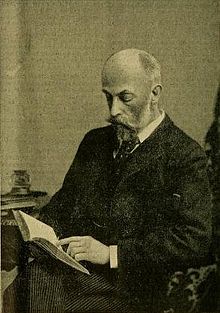
(The Gardeners' Chronicle 1899)
Sir William Turner Thiselton-Dyer KCMG CIE FRS FLS (28 July 1843 – 23 December 1928) was a leading British botanist, and the third director of the Royal Botanic Gardens, Kew.
Life and career
Thiselton-Dyer was born in Westminster, London. He was a son of William George Thiselton-Dyer (1812–1868), physician and Catherine Jane, née Firminger (1815–1897), botanist. He was educated at King's College School where he was first mathematical scholar, and later proceeded to the medical department of King's College London, where he remained until 1863 when he proceeded to Christ Church, Oxford. Initially studying mathematics at Christ Church, Oxford, he graduated in natural science in 1867. He became Professor of Natural History at the Royal Agricultural College in Cirencester and then Professor of Botany at the Royal College of Science for Ireland in Dublin. In 1872, he became professor at the Royal Horticultural Society in London, being recommended by Joseph Dalton Hooker. During the summers from 1872 to 1876, Thiselton-Dyer assisted T. H. Huxley in South Kensington with Huxley's summer courses for teachers.
In 1875, Thiselton-Dyer was appointed assistant director at the Royal Botanic Gardens, Kew, under Hooker, where he was to stay for thirty years. Thiselton-Dyer spent considerable time working for the benefit of the British colonies. He introduced rubber plantations to Sri Lanka and Malaya, and introduced cacao from Trinidad to plantations in Sri Lanka. In 1877, he was given charge of Jodrell Laboratory. This international research laboratory, established at Kew with private funding, became known as one of the best laboratories in Europe. Thiselton-Dyer also designed a new rock garden, after a bequest to Kew in 1881 of a large collection of Alpine plants. At Jodrell Laboratory, he was a mentor to Dunkinfield Henry Scott and H. Marshall Ward.
Thiselton-Dyer was elected FRS in 1880. His proposers included Charles Darwin and George Bentham, but not Joseph Dalton Hooker, whose daughter Dyer had already married. From 1885 to 1905, after the retirement of Hooker, he was director of the Royal Botanic Gardens.
As Director, in 1896 Dyer appointed the first women gardeners at Kew, Annie Gulvin and Alice Hutchins.
Thiselton-Dyer was a fellow of the University of London from 1887 to 1890, Royal Commissioner to the Paris International Exhibition (1900) and to the St. Louis Exposition (1904), botanical adviser to the Secretary of State for the Colonies (1902–1906), and became a member of the court of the University of Bristol in 1909. His principal works are an English edition of Sachs Text-Book of Botany (1875), editions of the Flora Capensis and of the Flora of Tropical Africa, and Index Kewensis (1905). With his former school-friend Henry Trimen he published The Flora of Middlesex (1869).
He married the botanical illustrator Harriet Anne Hooker, daughter of Joseph Dalton Hooker, in 1877; they had one son and one daughter. Harriet Anne Dyer (née Hooker) lived at Kew from birth until old age, surviving her husband and dying in 1946 aged 91, in her house near Bere Alston. Thiselton-Dyer was appointed KCMG in 1899, and awarded the Clarke Medal by the Royal Society of New South Wales in 1892. He was elected to the American Philosophical Society in 1905. He died at The Ferns (now Crickley Court), Witcombe, a village near Gloucester, and is buried in the churchyard of St Peter's, Bentham.
The standard author abbreviation Dyer is used to indicate this person as the author when citing a botanical name.References
- ^ William Turner Thiselton-Dyer (1843–1928) at Royal Botanic gardens, Kew
- ^ Geoffrey C. Ainsworth. Brief Biographies of British Mycologists (John Webster, David Moore, eds.), p. 162 (British Mycological Society; 1996) (ISBN 0952770407)
- "Lady gardeners of the 19th & 20th century | Kew". www.kew.org. Retrieved 16 April 2021.
- "No. 27435". The London Gazette. 20 May 1902. p. 3324.
- Durand, Théophile; Benjamin Daydon Jackson; William Turner Thiselton-Dyer; David Prain; Arthur William Hill; Edward James Salisbury (1908). Index Kewensis plantarum phanerogamarum: Supplementum Tertium Nomina et Synonyma Omnium Generum et Specierum AB Initio Anni MDCCCCI Usque AD Finem Anni MDCCCCV Complectens (suppl.3 (1901–1905) ed.). Royal Botanic Gardens, Kew. Retrieved 27 May 2008.
- Geison, Gerald L. "Thiselton-Dyer, William Turner". encyclopedia.com. Retrieved 11 January 2018.
- "Dyer, William Turner Thiselton-". Who's Who: 741. 1919.
- "APS Member History". search.amphilsoc.org. Retrieved 26 January 2024.
- International Plant Names Index. Dyer.
External links
 Media related to William Turner Thiselton-Dyer at Wikimedia Commons
Media related to William Turner Thiselton-Dyer at Wikimedia Commons Works related to author at Wikisource
Works related to author at Wikisource- "Archival material relating to William Turner Thiselton-Dyer". UK National Archives.

- Correspondence to William Thiselton-Dyer as Director of The Royal Botanic Gardens, Kew is being made available online through the Directors' Correspondence Project.
| Awards | ||
|---|---|---|
| Preceded byFrederick Hutton | Clarke Medal 1892 |
Succeeded byRalph Tate |
- English botanists
- English horticulturists
- 1843 births
- 1928 deaths
- Botanists active in Kew Gardens
- Fellows of the Linnean Society of London
- Fellows of the Royal Society
- Academics of the Royal Agricultural University
- Alumni of Christ Church, Oxford
- Alumni of King's College London
- Fellows of King's College London
- People educated at King's College School, London
- Knights Commander of the Order of St Michael and St George
- Companions of the Order of the Indian Empire
- People from Westminster
- 19th-century British botanists
- 20th-century British botanists
- Members of the American Philosophical Society